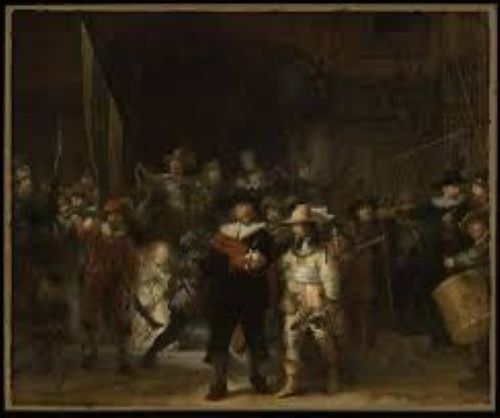
In the heart of 17th-century Amsterdam, the city of canals and commerce, there lived an artist whose name would become synonymous with mastery of light and shadow: Rembrandt Harmenszoon van Rijn. Born in 1606, he had grown to become one of the most renowned painters of his time, and his studio was always bustling with apprentices and students eager to learn from the master.
Rembrandt was a man of deep complexity, driven not only by the desire to create art but also by an insatiable curiosity about the human condition. His works often delved into the realms of emotion and psychology, and it was this fascination that led to the creation of one of his most celebrated and enigmatic paintings: "The Night Watch."
The painting, originally titled "Militia Company of District II under the Command of Captain Frans Banninck Cocq," was commissioned by Captain Cocq himself. It was to be a group portrait of the militia guardsmen of Amsterdam, a proud and powerful guild that protected the city from threats both domestic and foreign. The commission came with specific instructions: every member of the militia was to be depicted in the painting, and they were to be portrayed in action, not standing stiffly as was the custom for such portraits.
Rembrandt embraced the challenge with enthusiasm. He saw an opportunity to do more than create a simple portrait; he aimed to capture the essence of the men who made up this brave militia. As he often did, he sought to reveal the souls behind the faces and the stories behind the uniforms.
The scene he painted was a dramatic one. Illuminated by the warm, golden glow of a hidden source of light, the militia members were depicted at the very moment of stepping into action. Captain Cocq, resplendent in his black and red attire, stood at the forefront, his hand raised to give orders. Behind him, the members of the militia were caught in a whirlwind of movement. Some were adjusting their weapons, while others were preparing to march out into the night. Their faces revealed a mix of determination and anticipation, creating a tableau of both chaos and unity.
The background of the painting was richly textured, with hints of the city of Amsterdam itself. The dark night was punctuated by the bright uniforms and shimmering armor of the guardsmen, creating a striking contrast that drew the viewer's eye to the heart of the scene.
What made "The Night Watch" truly remarkable, however, was Rembrandt's mastery of light and shadow. He used chiaroscuro, a technique he had honed throughout his career, to create a sense of depth and three-dimensionality that was unparalleled. The play of light on the faces and armor of the militia members brought them to life, making them seem to emerge from the canvas itself.
The painting was unveiled to great acclaim in 1642, and it immediately became a sensation in Amsterdam. However, it was not without controversy. Some members of the militia were displeased with how they had been depicted, and there were even rumors that Rembrandt had hidden subversive messages within the painting. Despite this, "The Night Watch" endured as a masterpiece of Dutch Golden Age painting.
Over the centuries, the painting's reputation grew, and it became an iconic work of art, admired by art lovers and scholars alike. Today, it hangs in the Rijksmuseum in Amsterdam, a testament to the genius of Rembrandt and his ability to capture the human spirit in all its complexity, even in the dead of night. "The Night Watch" remains a timeless reminder that art has the power to illuminate not only the canvas but also the depths of the human soul.